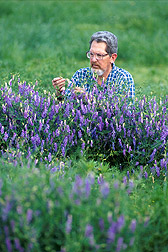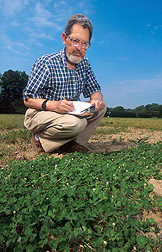Putting the Soil to Bed Over Winter . . .
|
|
|
|
Winter cover crops can provide farmers and gardeners a wealth of ecological and financial benefits—especially if those crops have been bred for improved local use.
"Farmers and gardeners throughout the United States need new nitrogen-fixing winter cover crops that can be better used in sustainable agricultural systems to reduce weed competition and herbicide applications, add symbiotically fixed nitrogen, and improve soil quality and tilth," says geneticist Thomas E. Devine at ARS' Sustainable Agricultural Systems Laboratory in Beltsville, Maryland. Over the years, he has spoken with many local farmers, extension agents, and scientists who have echoed the pressing need for reliable nitrogen-fixing cover crops. Those currently being used were bred for forage production. Devine has a master plan to fulfill these needs. He is breeding, testing, and selecting two potential species—hairy vetch and subterranean clover—to improve desired characteristics so these crops will be more useful to farmers and gardeners locally and to encourage their use in sustainable agricultural systems. Developing new cultivars can take 13 years or more.
|
|
|
A Simple, Efficient Cropping System
In the Chesapeake Bay watershed region, fields are seeded with hairy vetch or subterranean clover during the fall so the plants can grow some before the winter freeze. Within a week, seedlings emerge and grow several inches by the time frost arrives. The plants form a mat aboveground while their root systems create an extensive network underground. Foliage and root systems work together to hold the soil firmly, stop erosion from rain and wind, and exclude weeds during fall, winter, and early spring. Since these two cover crops are legumes, they form a symbiosis with specialized soil bacteria called rhizobia. The rhizobia make nodules on the plant roots, where they take nitrogen from the air and convert it to a form the plants can use to make proteins. The next crop planted after the cover crop can use this readily available nitrogen. Once the below-freezing weather arrives, the cover crops become dormant. "When spring comes," says Devine, "they start growing rapidly, forming a dense mat that smothers weeds and fixes nitrogen. At this time, summer crops of corn or other vegetables can be planted in the cover crop residue that's left after mowing or herbicide treatment." The residue effectively reduces weed emergence, increases soil organic matter, lowers water loss from the soil, and acts as a slow-release fertilizer, he says. |
|
|
Looking for the Best Clover
Since spring 1998, Devine has been evaluating accessions of subterranean clover,Trifolium subterranean, in USDA's germplasm collection and other collections to earmark those with greater winterhardiness, seedling vigor, and thatch production. He is testing them to determine whether genetic variability exists for these qualities. Devine chose subterranean clover because earlier research by colleague John R. Teasdale, an ARS plant physiologist, showed that the species was the best legume cover crop for suppressing weeds. "But in the Chesapeake Bay region, this legume's use is severely limited by its inability to consistently survive the stress of winter," Devine says. "A Mediterranean winter annual, subterranean clover has a prostrate growth habit. It forms a dense mat of stems close to the ground. So besides fixing nitrogen, the plant can feed the soil by providing organic matter to improve tilth, while forming a mat of thatch to suppress weeds." Subterranean clover seeded in the fall will flower in spring, producing seeds that the plant itself can burrow into the ground if the soil surface allows. Thus, the plant can reseed itself. After setting seed in the spring, subterranean clover plants die, leaving a dense layer of mulch. To find parental breeding material with these desirable characteristics, plus winterhardiness, Devine is evaluating 451 clover lines at the Beltsville research farm and the University of Maryland's Western Maryland Research and Education Center, Keedysville. His is the largest screening program with subterranean clover ever conducted in the United States. "Once we identify the best accessions, we'll use them as parental material for a breeding program to develop clover cultivars that we'll use in living mulch systems in the region," he says. "The lines we're evaluating include seven cultivars developed in Australia for forage production. Among these is the cultivar Mount Barker—traditionally the best performer in Maryland." In addition, Devine is screening a very large number of plant introductions obtained from the Australian subterranean clover germplasm collection. "We chose to evaluate these lines—originally from Europe—because they were collected from the more northern edge of the adaptation range of subterranean clover. So they're more likely to have the genes desired for greater winterhardiness," he says. Quest for the Best Vetch Since fall 1998, Devine has also been evaluating 53 accessions of hairy vetch,Vicia villosa, in the USDA germplasm collection to identify plants useful as parental material. His goal is to develop cultivars with earlier flowering and more vigorous cool-season growth for use in green manure/mulch systems for sustainable agriculture. "Green manure" refers to cover crops that have been tilled into the soil as fertilizer. "There are some limitations to using currently available varieties of the winter annual hairy vetch as a green manure or mulch cover crop," he says. These include late spring flowering and hard seed, which result in seedlings' sprouting at undesirable times in crop rotations. Irregular ripening and seed shattering cause losses in seed production and higher seed costs. Fall-seeded, overwintering hairy vetch plants can grow vigorously in the spring and fix large quantities of nitrogen. However, the vetch must be killed before it sets seed, or else most of the nitrogen will be tied up in the seed. Once the plants die, they release the fixed nitrogen to feed the subsequent crop. "This feeds plants naturally, which means farmers can avoid having to purchase and transport synthetic nitrogen fertilizer to the field for application," says Devine. "The dead stems also provide a blanket of mulch to repress weed growth in the next crop and preserve moisture." Devine is testing the hairy vetch accessions for several traits: early flowering, more vigorous growth during the fall (seedling vigor) and spring, flowering habit, uniform seed maturation for seed harvest, and absence of hard seed and seed shattering. "In the fall of 1999, we planted 15-foot rows of selections that we made from the 1998-1999 Beltsville field evaluation of hairy vetch lines from the USDA germplasm collection," he says. In spring 2000, Devine erected cages over selected vetch lines and then introduced bumblebees for cross-pollination. "Enclosing bumblebees permits us to control the pollen parent, as well as the female parent. We'll evaluate seed harvested from these plots this year," he says. "This year, we identified lines of subterranean clover with superior vigor of growth here in Maryland," he says. "We also identified plant introductions of hairy vetch with early flowering." Using these new varieties will benefit the environment by reducing siltation of streams, rivers, and lakes in the Chesapeake Bay watershed area. It will also preserve the soil's ability to produce healthy food for consumers at reasonable prices.—By Hank Becker, Agricultural Research Service Information Staff. This research is part of Crop Production, Product Value, and Safety, an ARS National Program (#302) described on the World Wide Web at http://www.nps.ars.usda.gov. Thomas E. Devine is at the USDA-ARS Sustainable Agricultural Systems Laboratory, Bldg. 001, 10300 Baltimore Ave., Beltsville, MD 20705-2350; phone (301) 504-6375, fax (301) 504-6491. |
|
"Putting the Soil to Bed Over Winter . . . " was published in the February 2001 issue of Agricultural Research magazine. |
|









